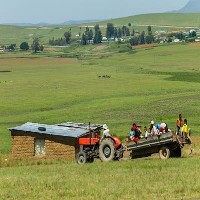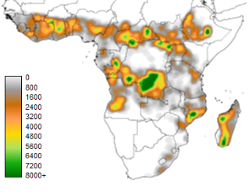Sustainable aviation biofuel supply chains in Sub-Saharan Africa
The WWF-SA and the Roundtable on Sustainable Biomaterials (RSB) are collectively undertaking a project to support the development of sustainable aviation biofuels in South Africa and the sub-Saharan Africa region. This initiative takes place in the wake of the aviation industry’s increasing interest in the use of biofuels as an alternative fuel. WWF-SA commissioned IIASA to conduct a spatially detailed resource assessment for different biofuel feedstocks and develop a set of scenarios up to 2050 to assess biofuel feedstock potentials for sub-Saharan Africa, subject to defined sustainability criteria.
The IIASA/FAO Global Agro-Ecological Zones (GAEZ) modelling system was applied for the estimation of the production potential of bio-energy feedstocks across Sub-Saharan Africa. Additional feedstocks of particular interest for aviation biofuels including a variety of solaris (tobacco), triticale and camelina were integrated into the GAEZ assessment. GAEZ together with IIASA’s World Food System (WFS) are the main components of the ecological-economic modelling framework that connects biophysical and socio-economic processes on a global scale. It was used to analyze two development scenarios to estimate the sustainable biofuel potentials that are compatible with long-term food security and environmental integrity.
Cumulative biofuel feedstock potential from REMAIN land in a circle of 100 km, 2010
The map shows for each pixel the estimated cumulative potnetial production (in TJ equivalent) using crop biomass of sugarcane and miscanthus from prime, good and moderately suitable rain-fed REMAIN land subject to a 60% GHG Critierion. © IIASA
The study applies a set of defined sustainability criteria, developed by the RSB and considered best-in-class. They include land use and conservation (no deforestation, preserve protected areas and areas of high environmental value), food security (retain adequate land for food production), greenhouse gas emission savings (minimum of 60% savings compared to fossil fuels when using a 20-year accounting period), and water security (only rain-fed biofuel production considered).
Results of the study regarding the availability and productivity of land reserves in sub-Saharan Africa indicate for 2010 the existence of some 1.9 million km2 grass- and shrubland. These areas (termed REMAIN land) are in excess of land that is needed to achieve food security, land that is legally protected or land that should be set aside for nature conservation and environmental protection, including forest land, key biodiversity areas and wetlands.
However, exploitation of these land resources, requiring land conversion from natural shrub land and grasslands to cropland followed by intensive feedstock cultivation practices, will result in substantial initial carbon debts due to the removal of the existing vegetation and the partial loss of soil carbon.
The transition to a low-carbon economy with biomass as one of its energy sources will intensify the energy-agriculture linkage and add a new dimension to agricultural systems, heighten resource competition in the food system, and may provide new opportunities for rural communities. The study reveals that increasing biofuel feedstock production in Sub-Saharan Africa, while at the same time meeting food demand targets and strictly following sustainability principles, faces a high degree of complexity. The study highlights that attaining the sustainability goals and avoid unintended consequences of increased biofuel use requires next to sustainability criteria, an analysis of future development pathways.


Timeframe
May 2016 - December 2018
RESEARCH PARTNERS
PUBLICATIONS



